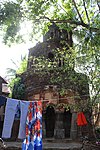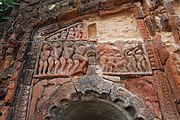Kayapat
Kayapat | |
|---|---|
Village | |
Location in West Bengal, India | |
| Coordinates: 22°54′16″N 87°32′17″E / 22.904523°N 87.538172°E | |
| Country | |
| State | West Bengal |
| District | Hooghly |
| Population (2011) | |
| • Total | 3,351 |
| Languages | |
| • Official | Bengali, English |
| Time zone | UTC+5:30 (IST) |
| PIN | 712122 |
| Telephone/STD code | 03211 |
| Lok Sabha constituency | Arambagh |
| Vidhan Sabha constituency | Goghat |
| Website | hooghly |
Kayapat is a village in the Goghat II CD block in the Arambagh subdivision of Hooghly district in the Indian state of West Bengal.
Geography

5miles
River
River
River
River
Bayara
M: municipal city/ town, R: rural/ urban centre, H: historical/ religious centre
Owing to space constraints in the small map, the actual locations in a larger map may vary slightly
Area overview
The Arambagh subdivision, presented in the map alongside, is divided into two physiographic parts – the Dwarakeswar River being the dividing line. The western part is upland and rocky – it is extension of the terrain of neighbouring Bankura district. The eastern part is flat alluvial plain area. The railways, the roads and flood-control measures have had an impact on the area.[1] The area is overwhelmingly rural with 94.77% of the population living in rural areas and 5.23% of the population living in urban areas.[2]
Note: The map alongside presents some of the notable locations in the subdivision. All places marked in the map are linked in the larger full screen map.
Location
Kayapat is located at 22°54′16″N 87°32′17″E / 22.904523°N 87.538172°E
Demographics
As per the 2011 Census of India, Kayapat had a total population of 3,351 of which 1,737 (52%) were males and 1,614 (48%) were females. Population in the age range 0–6 years was 340. The total number of literate persons in Kayapat was 2,578 (85.62% of the population over 6 years).[3]
Culture
David J. McCutchion mentions the Sridhara temple of Mondal family as having been built in 1807 as a nava ratna with rich terracotta façade. He also mentions a pancha ratna temple with terracotta decoration.[4]
Kayapat picture gallery
-
Sridhar Laljiu temple of Mondal family, built in 1807 (front side).
-
Sridhar Laljiu temple built as a nava ratna temple, now in a ruinous condition (rear side).
-
Crumbling terracotta designs at Sridhar Laljiu temple
-
At chala temple adjacent to Sridhar Laljiu temple
The pictures are a part of Wiki Explores Hooghly programme, an initiative by West Bengal Wikimedians User Group
References
- ^ "District Census Handbook: Hugli, Series-20, Part XIIA" (PDF). Physiography, Page 17-19. Directorate of Census Operations, West Bengal, 2011. Retrieved 25 September 2020.
- ^ "District Statistical Handbook 2014 Hooghly". Table 2.2, 2.4(a). Department of Planning and Statistics, Government of West Bengal. Retrieved 25 September 2020.
- ^ "2011 Census – Primary Census Abstract Data Tables". West Bengal – District-wise. Registrar General and Census Commissioner, India. Retrieved 22 September 2020.
- ^ McCutchion, David J., Late Mediaeval Temples of Bengal, first published 1972, reprinted 2017, pages 46, 52. The Asiatic Society, Kolkata, ISBN 978-93-81574-65-2






